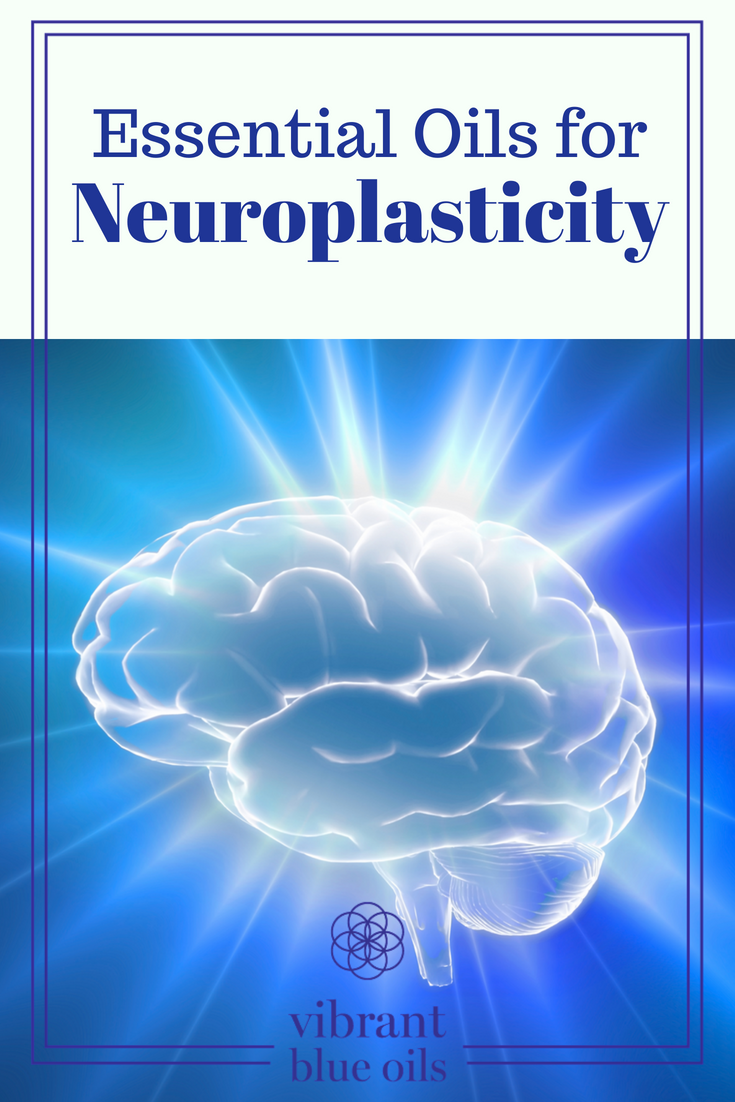Essential Oils for Neuroplasticity are ideal tools for supporting the brain as the olfactory channel carries them directly into the brain.
They can also be topically applied to stimulate specific areas of the brain. For example, using the Parasypmathetic™ blend to stimulate the vagus nerve (behind the ear lobe on the mastoid bone) can both trigger the parasympathetic state and re-wire the brain to trigger the parasympathetic state more easily with every use. Similarly, stimulatory oils, like our Brain Balance blends for Focus™, Attention™, or Brain Boost™ can be applied to specific regions of the brain to stimulate and rewire neural pathways, a concept known as neuroplasticity.
It is important to note that neuroplasticity is not a one-size-fits-all magic bullet. It has tremendous benefit when used in very specific ways with proper dietary and nutritional support. Just as nutrition is highly bio-individual, the science of neuroplasticity has to be customized to each individual. Each brain is different and what helps one person might hurt another.
The information below is designed to help you Use Essential Oils for Neuroplasticity to ensure positive, not negative, re-wiring.
How to Use Essential Oils for Neuroplasticity
As you may know, the brain needs three things:
- Oxygen
- Glucose
- Stimulation

All three must be in place to build a healthy brain. For the past year, I have been studying functional neurology with Datis Kharrazian, the man who literally wrote the book on Brain Health. According to Kharrazian, if you stimulate a brain that is deprived of oxygen or glucose, the additional stimulation to an already fatigued brain will further fatigue the brain and cause damage. This is also true if you over-stimulate it beyond the point of fatigue, for example if the brain starts to fatigue after 20 seconds and you continue stimulating beyond the point of fatigue, you are hurting the brain.
Just as you would never continue to run on a stress fracture as it would only cause further damage, stimulating an already fatigued brain beyond capacity will will contribute to further faulty wiring, creating negative, not positive Neuroplasticity. This is one of the reasons that Dr. Kharrazian and his partner, acclaimed functional neurologist, Brandon Brock created this intense yearlong course, to provide doctors with the clinical assessment tools to safely use Neuroplasticity on clients.
What is Neuroplasticity?
The idea behind Neuroplasticity is that the brain creates communication pathways that help make frequent thoughts and behaviors most efficient. The more we repeat a thought or activity, the more readily available those pathways become. For example, the more you practice a foreign language, musical instrument or sport, the easier and more automatic it becomes. This is true for negative and positive, or negative, thought patterns as well.
The idea is to rewire the brain for positive Neuroplasticity and reframe negative thought patterns, behaviors and physiological responses. If we repeat negative thoughts and behaviors, like those related to anxiety, depression, worry, fear, anger or grief, the brain will wire itself to make those negative Neuroplasticity patterns more efficient.
Similarly, if we over-stimulate a brain that is deprived of oxygen and glucose and therefore too fatigued to receive new positive stimuli, negative neuroplasticity patterns can develop. It’s a little bit like fueling exhausted adrenals with triple shots of espresso. You can stimulate the body and brain to function, but deplete the underlying adrenals even further. It holds true that networks that fire together wire together and faulty input creates faulty output.
A Bio-Individual Approach to Neuroplasticity
Just as you might approach nutritional support by looking at what the body needs, it is important to approach brain support in the same way. Protocols for Neuroplasticity should be customized for each individuals based on the area and side of the brain that need stimulation and the duration of the stimulation based on when fatigue begins to set in.
It is important to assess and support the following areas before beginning any aggressive protocol to rewire the brain:
- Oxygen
- Glucose
- Stimulation
If an issue, like pain or inflammation, is effecting both sides of the body, for example you experience pain in both knees, it is likely that nutritional issues, including oxygen and glucose, are the underlying cause and needs to be addressed first. If you only experience an issue on one side of the body, then is can often be addressed by strengthening that area of the brain.
Essential Oils for Neuroplasticity
The following assessments, in combination with Essential oils can be used to support all of these areas.
Essential Oils to Oxygenate the Brain
Healthy circulation is critical for delivery of oxygen and nutrient rich blood to the body and the brain, while simultaneously carrying toxins and waste to the kidney and liver to be eliminated.
An easy way to assess healthy circulation is to look at the circulation of the distal extremities like the fingers, toes and brain. Also, the brain is the most vertical tissue and is consistently dealing with the forces of gravity due to its vertical position.
Symptoms of Poor Circulation
- No Brian endurance for focus and concentration
- Cold hands and face
- Must exercise or drink coffee to improve brain function
- Poor nail health or white (instead of pink) on the nail beds
- Fungal growth on toenails
- Prefer to wear socks at night
- Nail beds are white instead of pink
- The tip of the nose is cold
- Hair thinning or falling out
All of these indications reflect the lack of blood flow and nutrients to extremities. For example, blood flow to the scalp is responsible for caring hormones and essential nutrients needed by the hair follicles. Therefore when circulation is compromised to the head, many individuals complain of hair falling out and thinning.
You can also touch the distal extremities, like the fingers the toes and the nose, and compare the temperature to that of the arms and the legs or the rest of the face. The temperature should be the same on both the distal extremity and the body if circulation is healthy.
Essential Oils to Stimulate Blood Flow in the Veins and Improve Circulation
 Breathe™: Formulated with three different types of Eucalyptus essential oil, which is known as a great vasodilator. As it enters the body, eucalyptus essential oil increases the blood flow by relaxing the blood vessels, thereby allowing more blood to circulate. Breathe can also help improve blood and oxygen flow to the brain. If poor circulation makes you feel tired or fatigued, apply 1 – 2 drops of Breathe™ over the heart and lungs.
Breathe™: Formulated with three different types of Eucalyptus essential oil, which is known as a great vasodilator. As it enters the body, eucalyptus essential oil increases the blood flow by relaxing the blood vessels, thereby allowing more blood to circulate. Breathe can also help improve blood and oxygen flow to the brain. If poor circulation makes you feel tired or fatigued, apply 1 – 2 drops of Breathe™ over the heart and lungs.
Heart™: The heart integrates and balances the physical, emotional, and mental body, providing blood to every cell and every organ. The heart is also our body’s reset button, but a state of constant stress can fatigue the heart and compromise our ability to reset, leading to inflammation, infections, toxicity and heart disease. To return the heart to balance, support circulation and balance blood pressure, apply 1 -2 drops of Heart™ over the heart.
Energize™: Formulated to improve circulation and restore the body’s vitality and energy, Energize contains several powerful oils like Geranium to help to improve poor circulation by toning the blood vessels and Peppermint to help facilitate blood flow. To apply, massage 1 -2 drops of Energize™ over the heart.
Lymph™ : The Lymphatic system works in tandem with the circulatory system. Lymph™ is uniquely formulated to increase circulation of fats and white blood cells within the lymphatic system for optimal delivery of nutrients to cells and removal of waste from the cells. To apply, massage 1- 2 drops each to sides of neck, lymph nodes under arms and around inguinal ligament (bikini line area).
Peppermint™: Known to improve circulation, boost energy and relax muscles. To apply, just smell or massage a drop or two over the heart.
Essential Oils to Support Optimal Brain Glucose
Glucose is fuel for the brain and the brain needs a constant steady supply of glucose at all times to function properly. Although the brain weighs only about two or 3 pounds it uses about 30% of the body’s total glucose.
Besides being the essential fuel source for neurons in the brain, glucose and insulin responses have significant impacts on amino acid transport across the blood brain barrier and proper glucose metabolism is critical for balanced neurochemistry
It is therefore important to keep glucose levels in the blood (known as Blood sugar) balanced and steady for optimal brain function.
Symptoms of Blood Sugar Imbalances
- Crave sweets like sugar, carbohydrates or coffee?
- Feel sleepy or have energy dips in afternoon
- Feel irritable or shaky if meals are skipped or delayed
- Have difficulty concentrating before eating
- Have trouble falling asleep or awaken hours after going to bed and find it difficult to go back to sleep
- Feel fatigued after meals
- Collect weight in your abdomen or have difficulty losing weight?
- Frequent thirst and/or urination
- Need stimulants such as coffee after meals
How Does Blood Sugar Work?
Carbohydrates in the food we eat are digested and absorbed as glucose, then transported through the bloodstream, supplying energy to every cell in the body. The body is continually monitoring the levels of glucose (blood sugar) in the blood to ensure that it doesn’t spike too high or dip too low. The goal is to maintaining a condition of internal stability necessary for optimal function.
Keeping blood sugar in balance is important for:
- Energy levels, including optimal sleep
- Brain health, including moods and mental focus.
- Hormonal balance
- Weight loss
- Optimal health, including the optimal function of every organ
Diet is a primary tool for controlling blood sugar, ideally limiting the intake of foods that spike blood sugar, like sugar and carbohydrates. Increasing the intake of healthy fats, and supporting the body’s ability to digest and assimilate fats, can also help curb hunger cravings and sustain blood sugar levels for longer periods of time.
Essential Oils that Support the Organs of Blood Sugar Regulation
Pancreas™: The digestive system breaks down the carbohydrates from food into glucose which goes straight into the bloodstream, causing blood sugar concentrations to rise. The pancreas releases insulin to transport the glucose into the cells. As more and more cells receive glucose, blood sugar levels come down to normal again. Excess glucose is stored as glycogen (stored glucose) in the liver and muscles. If you have not eaten for a while and blood glucose concentrations drop, the pancreas releases another hormone called glucagon. Glucagon triggers the breakdown of glycogen into glucose, thus pushing blood glucose levels back up to normal.
Liver™: The liver acts as the body’s glucose (energy) reservoir and helps to maintain steady and constant blood sugar levels by balancing the uptake, storage and release of glucose depending on the body’s need for energy. More specifically, excess glucose is removed from the blood, and converted into glycogen (the storage form of glucose) which is stored in the liver. When blood sugar levels drop, the liver initiates a process called glycogenolysis where glycogen is converted back into glucose, and gradually released into the bloodstream until levels approach normal range. If the body’s glycogen stores dwindle, the liver helps to produce glucose through a process known as gluconeogenesis or by converting other sugars into glucose. Finally, the liver produces ketones from fats when glucose is in short supply.
Adrenal®: A blood sugar imbalances can exhaust the adrenals. For example, eating a sugary meal will spike then quickly crash blood sugar, requiring the adrenals to release cortisol to stabilize blood sugar. Similarly, stress hormones such as adrenaline (epinephrine) can increase blood sugar levels to meet your body’s demands for energy. Every stress response is a blood sugar response and fatigued adrenal glands can drop cortisol, and blood sugar, levels.
Essential Oils to Support Optimal Brain Stimulation
Vibrant Blue Oils Brain Balance blends like Focus™, Brain Boost™, Anti Inflammatory™ and/or Attention™ can be used to provide gentle stimulation to specific regions of the brain in order to activate the neural pathways used in the processing of this stimulatory information.
Neuronal connections in these pathways are strengthened and new connections are established through repeated sessions of multi-sensory input. This can include exercises like eye tracking and physical movement to stimulate that area of the brain.
One key point to note is that stimulation is often focused more heavily on one side of the body than the other, almost always on the weaker side. This is one reason it is important to work with a professional trained in functional neurology to help assess both what region and what side of the brain need to be stimulated. The goal is to strengthen the weaker side to return the body to balance. Strengthening the stronger side will merely throw off the imbalance even more.
That said, it is important to accurately identify both the region of the brain that needs to be stimulated and the weaker side to stimulate to bring the brain into balance. This can be determined both through a detailed checklist and a visit to a chiropractor trained functional neurology who can observe as you complete different physical tasks like rapidly rotating your hands at the same time to see which fatigues more quickly or balancing on one leg with eyes both open and closed. A trained professional will be able to identify:
- The region of the brain that needs stimulating
- The weaker side of the brain that needs strengthening to bring the entire brain back into balance
- The point at which fatigue sets in and the stimulatory exercise should be discontinued.
This last point is key. It is important to work with a trained professional to assess how much endurance you have for stimulating the brain. It is unfortunately common for people to fatigue the brain when they are attempting to rehabilitate the brain. They overdo it, the brain crashes and they end up getting worse than before. Datis Kharrazian uses the example of rehabilitating a torn biceps by gently lifting some weights. “If you do it too aggressively, you’re going to reinjure yourself. It’s the same thing when you look at brain development issues, brain injuries, neurodegenerative issues. You have to figure out what your endurance is.”
There is where it is important to enlist a trained professional guide you through the decision-making tree of how much stimulatory oil to apply and where to apply it. There are times where people can’t handle direct activation, for example, if an area of the brain is too fatigued or too compromised from having symptoms. A trained professional can guide you to activate something that’s pre-synaptic to it; something that fires into it. So if the frontal cortex is involved, they might suggest cerebellar therapy, because it fires into the cortex and can help you develop some connectivity without doing damage.
Because of this micro targeting, you want to be careful not to apply a stimulatory oil to an area of the brain where many aspects can be stimulated and more quickly fatigue the brain. For example, it is not adviseable to apply stimulatory essential oils directly to the brain stem (the back center of the head, at the ridge where the neck meets the skull), as this application point was too intense for most clients. We originally looked at this point of application for the Parasympathetic blend as this is where the vagal nerve originates, but quickly realized that it also stimulates many other nerves in addition to the vagal nerve, opening the potential to overstimulate the brain and cause more damage.
Our gentle application behind the ear lobe on the mastoid bone with our Parasympathetic blend of Clove and Lime isolates and stimulates the Vagal Nerve in a very targeted and gentle way to avoid any harm. Because it is designed to gently drop the body into the Parasympathetic state which enhances the body’s ability to balance and heal without impact other areas of the brain, it is safe to apply even if circulation and blood sugar are compromised.
Our other Brain Balance oils make wonderful tools for Neuroplasticity when used with the guidance of a trained professional We are all different, most Neuroplasticity should be customized for each individuals specific needs and goals.
Resources
Ready to get started? Click the links below to order today:
- Adrenal® available here
- Anti Inflammatory™ available here
- Attention™ available here
- Brain Boost™ available here
- Breathe™ available here
- Energize™ available here
- Focus™ available here
- Heart™ available here
- Liver™ available here
- Lymph™ available here
- Peppermint™ available here
- Pancreas™ available here




